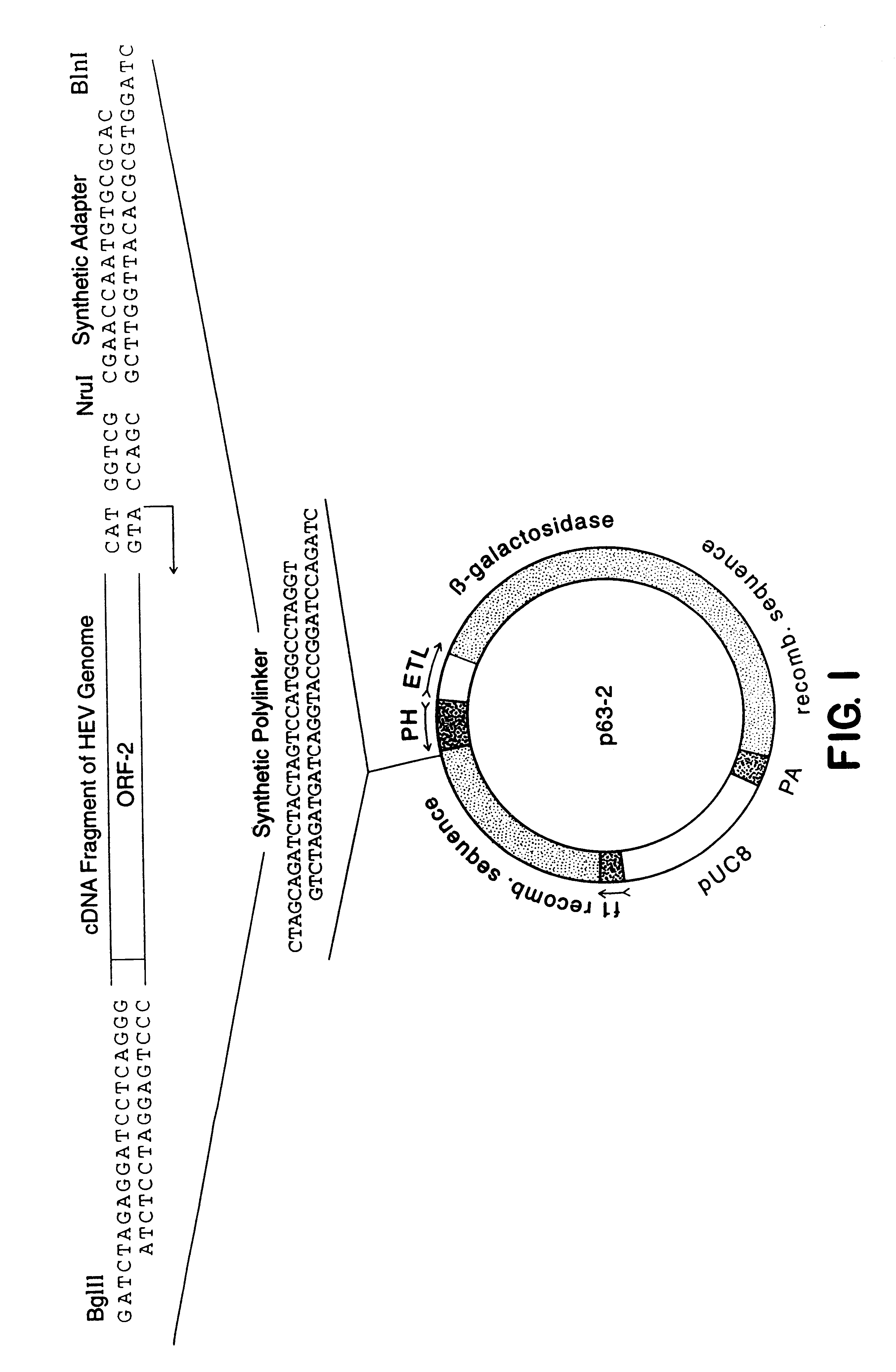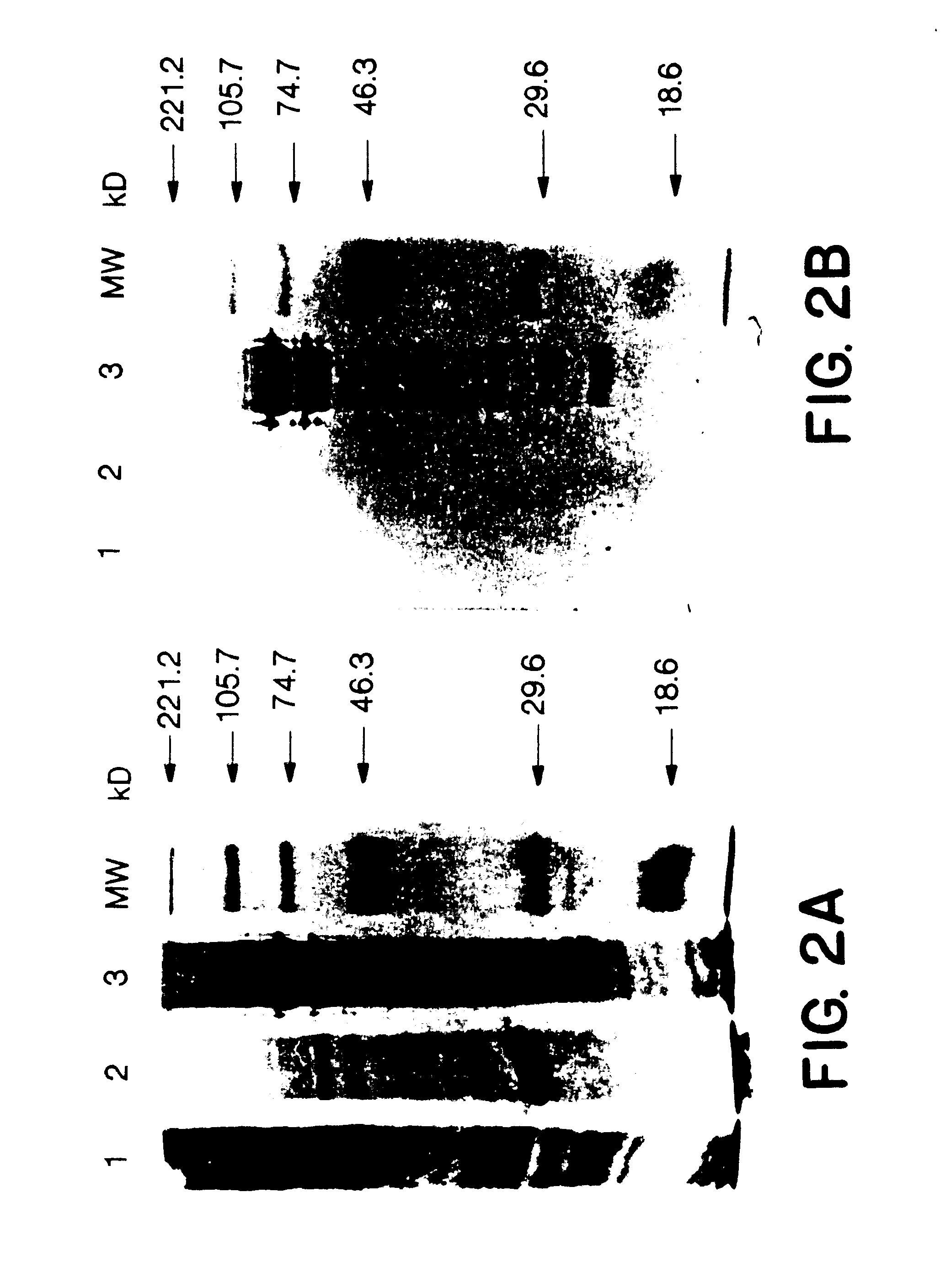Recombinant proteins of a Pakistani strain of hepatitis E and their use in diagnostic methods and vaccines
- Summary
- Abstract
- Description
- Claims
- Application Information
AI Technical Summary
Benefits of technology
Problems solved by technology
Method used
Image
Examples
example 1
Identification of the DNA Sequence of the Genome of HEV Strain SAR-55
Preparation of Virus RNA Template for PCR. Bile from an HEV-infected cynomolgus monkey (10 .mu.l), 20% (wt / vol) SDS (to a final concentration of 1%), proteinase K (10 mg / ml; to a final concentration of 1 mg / ml), 1 .mu.l of tRNA (10 mg / ml), and 3 .mu.l of 0.5 M EDTA were mixed in a final volume of 250 .mu.l and incubated for 30 min. at 55.degree. C. Total nucleic acids were extracted from bile twice with phenol / chloroform, 1:1 (vol / vol), at 65.degree. C. and once with chloroform, then precipitated by ethanol, washed with 95% ethanol, and used for RT-PCR. RT-PCR amplification of HEV RNA from feces and especially from sera was more efficient when RNA was more extensively purified. Serum (100 .mu.l ) or a 10% fecal suspension (200 .mu.l) was treated as above with proteinase K. After a 30-min incubation, 300 .mu.l of CHAOS buffer (4.2 M guanidine thiocyanate / 0.5 N-lauroylsarocosine / 0.025 M Tris-HCL, pH 8.0) was added. N...
example 2
Construction of a Recombinant Expression Vector, P63-2
A plasmid containing the complete ORF-2 of the genome of HEV strain SAR-55, Tsarev, S. A. et al. (1992), Proc. Natl. Acad. Sci. USA, 89:559-563), was used to obtain a restriction fragment NruI-BglII. NruI cut the HEV cDNA five nucleotides upstream of the ATG initiation codon of ORF-2. An artificial Bgl II site previously had been placed at the 3' end of HEV genome just before the poly A sequence (Tsarev, S. A. et al. (1992), Proc. Natl. Acad. Sci. USA, 89:559-563). To insert this fragment into pBlueBac-Transfer vector (Invitrogen) a synthetic polylinker was introduced into the unique NheI site in the vector. This polylinker contained Bln I and Bgl II sites which are absent in both HEV cDNA and pBlueBac sequences. The NruI-BglII ORF-2 fragment was inserted in Bln I-BglII pBlueBac using an adapter as shown in FIG. 1.
example 3
Expression of P63-2 in SF9 Insect Cells
p63-2 and AcMNPV baculovirus DNA (Invitrogen) were cotransfected into SF9 cells (Invitrogen) by the Ca precipitation method according to the Invitrogen protocol--By following this protocol; the AcMNPV baculovirus DNA can produce a live intact baculovirus which can package p63-2 to form a recombinant baculovirus. This recombinant baculovirus was plaque-purified 4 times. The resulting recombinant baculovirus 63-2-IV-2 was used to infect SF9 cells.
SDS-PAGE and Western blot. Insect cells were resuspended in loading buffer (50 mM Tris-HCl, pH 6.8, 100 mM DTT, 2% SDS, 0.1% bromphenol blue and 10% glycerol) and SDS-polyacrylamide gel electrophoresis was performed as described, Laemmli, U. K. (1970), Nature, 227:680. Gels were stained with coomassie blue or proteins were electroblotted onto BA-85 nitrocellulose filters (Schleicher & Schuell). After transfer, nitrocellulose membranes were blocked in PBS containing 10% fetal calf serum and 0.5% gelatin. ...
PUM
| Property | Measurement | Unit |
|---|---|---|
| Atomic weight | aaaaa | aaaaa |
| Atomic weight | aaaaa | aaaaa |
| Volume | aaaaa | aaaaa |
Abstract
Description
Claims
Application Information
 Login to View More
Login to View More - R&D
- Intellectual Property
- Life Sciences
- Materials
- Tech Scout
- Unparalleled Data Quality
- Higher Quality Content
- 60% Fewer Hallucinations
Browse by: Latest US Patents, China's latest patents, Technical Efficacy Thesaurus, Application Domain, Technology Topic, Popular Technical Reports.
© 2025 PatSnap. All rights reserved.Legal|Privacy policy|Modern Slavery Act Transparency Statement|Sitemap|About US| Contact US: help@patsnap.com



